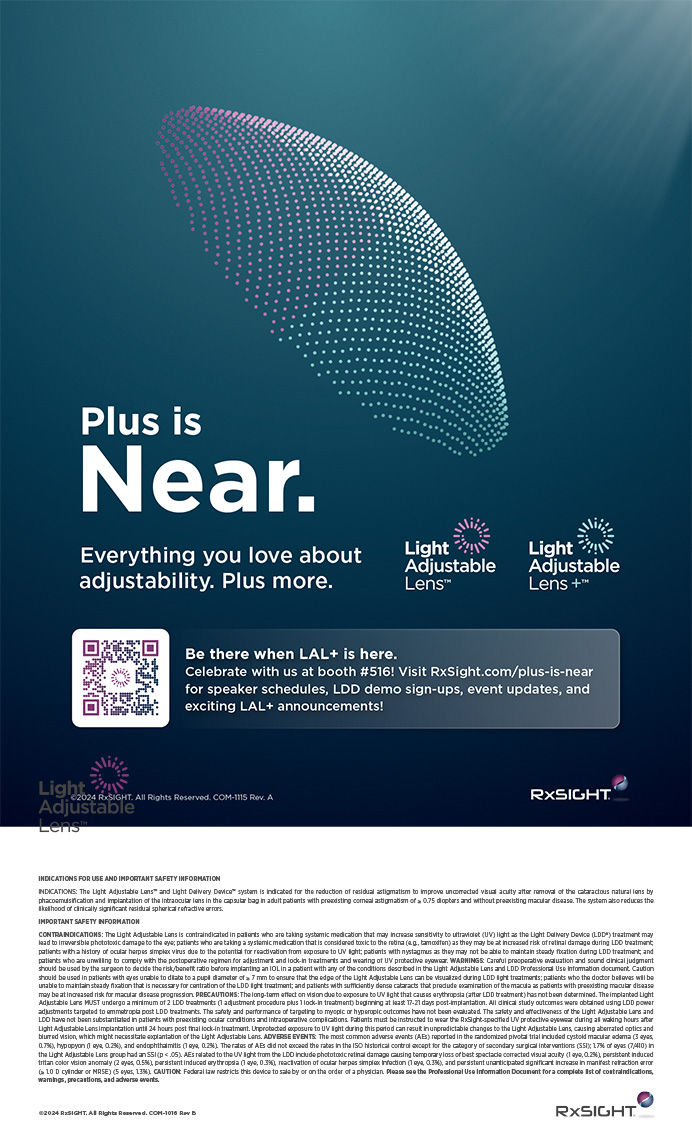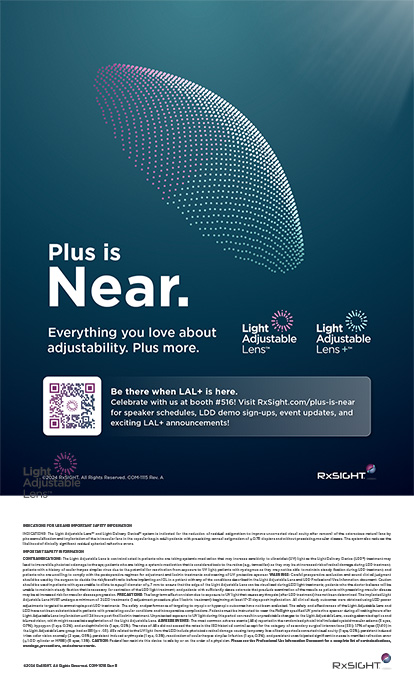
Utility of Three-Dimensional Heads-up Surgery in Cataract and Minimally Invasive Glaucoma Surgeries
Ohno H1
Industry support: No
ABSTRACT SUMMARY
The novel method of conducting surgery using a 3D heads-up digital visualization system has been widely accepted by vitreoretinal surgeons, and these systems have recently come into use for anterior segment surgery. Use of these systems allows surgery to be performed under less intense light and with extended depth of field magnification in comparison with the use of conventional operating microscopes. Surgeons are also able to view information such as intraoperative OCT images and phaco settings simultaneously on the display.
Study in Brief
A study of the utility of a 3D heads-up digital visualization system for cataract surgery and MIGS demonstrated good visualization and increased surgeon comfort for this system compared to when a conventional microscope was used.
WHY IT MATTERS
The use of a 3D heads-up digital visualization system is relatively new to anterior segment surgeons. This study showed its compatibility with modern cataract and glaucoma surgery.
This study assessed the utility of a 3D digital visualization system (Ngenuity, Alcon) for minimal-incision cataract surgery and MIGS, specifically the implantation of a trabecular microbypass stent. The Verion (Alcon) image-guided system was used to assist with toric IOL alignment during surgery. Ohno compared surgical visualization, outcomes, and surgeon comfort during cases performed using these systems versus conventional surgery.
Cataract surgery and MIGS were compatible with both the Ngenuity and Verion. Ohno noted that a frequent adjustment of focus was not required for MIGS but was necessary for surgery using a conventional microscope. Reasons suggested for the difference were the enhanced stereoscopic view and extended depth of field at high magnification provided by the 3D digital visualization system. Additional advantages of the digital visualization system were lower light intensity, exaggeration of the structure and color of the image, and an ability to process the original image on the display exactly according to the surgeon’s preference without reducing image quality.
DISCUSSION
Other studies have demonstrated similar levels of safety and surgical times with a traditional microscope and a 3D digital visualization system.1-5 A larger display that can be customized to the surgeon’s preferences and less time spent focusing in and out can simplify the operating environment and increase surgical efficiency.1-3 Lower requirements for light intensity during 3D anterior segment surgery may hasten visual recovery and improve patient comfort.1,3
Efficacy of 3D Digital Visualization in Minimizing Coaxial Illumination and Phototoxic Potential in Cataract Surgery: Pilot Study
Rosenberg ED, Nuzbrokh Y, Sippel KC3
Industry support: E.D.R. and K.C.S., consultants (Alcon)
ABSTRACT SUMMARY
This study compared the coaxial light intensity required during laser cataract surgery and the rate of postoperative visual recovery when a traditional analog operating microscope (OPMI Lumera 700, Carl Zeiss Meditec; n = 24 eyes) or a 3D digital visualization system (Ngenuity; n = 27 eyes) was used. UCVA and BCVA were assessed at 1 day and 1 month after surgery.
Study in Brief
A retrospective, consecutive, single-surgeon series compared the coaxial light intensity required during laser cataract surgery and the rate of postoperative visual recovery when a standard operating microscope or a 3D digital visualization system was used. Mean light intensity was significantly less and postoperative visual recovery was faster in the digital group.
WHY IT MATTERS
Toxicity induced by the microscope light is of concern in cataract surgery. The use of a 3D digital visualization system appears to reduce the risk of this toxicity, hasten visual recovery, and improve patient comfort.
No post- or intraoperative complications were observed. Postoperative BCVA was 20/20 or better in all patients except one who had a history of advanced exudative macular degeneration.
There was no significant difference in mean light exposure time (25.8 ±3 minutes in the traditional group vs 23.8 ±1.9 minutes in the digital group). Mean light intensity, however, was significantly lower in the digital group than in the traditional group (18.5 ±1.5% vs 43.3% ±3.7%). A greater percentage of eyes in the digital group achieved a visual acuity at postoperative day 1 that was within 2 lines of the visual acuity observed at postoperative month 1 (81.5% vs 54.2%).
DISCUSSION
Attempts have been made to decrease the risk of toxicity induced by the microscope light. These have employed various means, including filtering illumination with a corneal shield, increasing the homogeneity of illumination at the level of the retina, filtering blue and UV light, and tilting the microscope off axis so that the coaxial light is focused adjacent to the fovea. Microscope manufacturers and the International Commission on Non-Ionizing Radiation Protection recommend using the lowest light intensity possible for the shortest period of time possible while still maintaining optimal visualization. The recommended safe exposure times, however, are substantially shorter than the typical duration of cataract surgery (1.1–3.7 minutes depending on surrounding field illumination at 50% light intensity).1-3
Using a 3D digital visualization system significantly decreased light intensity in this study without increasing the incidence of complications or prolonging surgery.
Both of the studies discussed in this article focus on the Ngenuity. Researchers, however, have also begun assessing the utility of the Artevo 800 (Carl Zeiss Meditec) for anterior segment surgery.6
1. Ohno H. Utility of three-dimensional heads-up surgery in cataract and minimally invasive glaucoma surgeries. Clin Ophthalmol. 2019;13:2071-2073.
2. Qian Z, Wang H, Fan H, Lin D, Li W. Three-dimensional digital visualization of phacoemulsification and intraocular lens implantation. Indian J Ophthalmol. 2019;67(3):341-343.
3. Rosenberg R, Nuzbrokh Y, Sippel K. Efficacy of 3D digital visualization in minimizing coaxial illumination and phototoxic potential in cataract surgery: pilot study. J Cataract Refract Surg. 2021;47(3); 291-296.
4. Adam MK, Thornton S, Regillo CD, Park C, Ho AC, Hsu J. Minimal endoillumination levels and display luminous emittance during three-dimensional heads-up vitreoretinal surgery. Retina. 2017;37(9):1746-1749.
5. Weinstock RJ, Diakonis VF, Schwartz AJ, Weinstock AJ. Heads-up cataract surgery: complication rates, surgical duration, and comparison with traditional microscopes. J Refract Surg. 2019;35(5):318–322.
6. Kaur M, Titiyal JS. Three-dimensional heads up display in anterior segment surgeries – expanding frontiers in the COVID-19 era. Indian J Ophthalmol. 2020;68(11):2338-2340.




